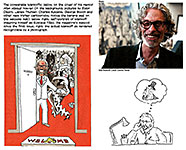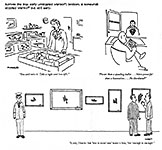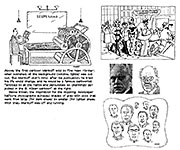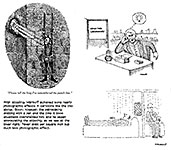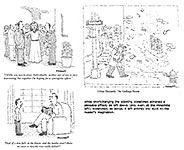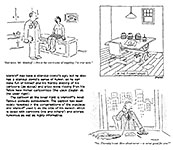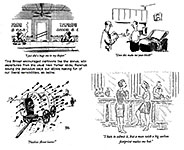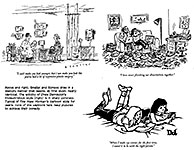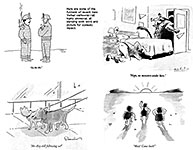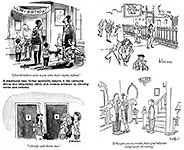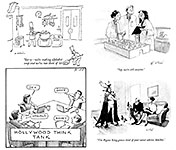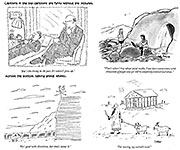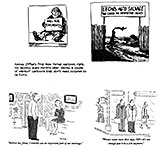|
TWO DECADES AS NEW YORKER CARTOON EDITOR The Incomparable Mankoff
On Thursday, March 2, 2017 at 1:30 in the afternoon, David Remnick, editor of The New Yorker, sent a memo to the magazine’s roster of cartoonists. A minute later, the same memo arrived at the inboxes of the rest of the staff. "We are going to have a change,” Remnick began, quoted by James Warren at poynter.org, “—after more than two decades as cartoon editor, the incomparable Bob Mankoff is stepping aside from that post and assuming what is arguably a higher post, that of a regularly contributing artist. Bob has been a remarkable and innovative partner to me, as he was to Tina Brown [Remnick’s predecessor]. He brought a real sense of originality to this work, but, even more important, a sense of the artists and their interests. He has brought everyone’s best work to the table and managed a complicated balancing act with grace, sustaining the work of people who have been publishing in The New Yorker for many years while bringing new artists into the mix, including more diverse voices and views of the world." "A huge antic talent and wonderful wry observer," Tina Brown told Warren. "I saw how special he was immediately and will always be proud I made him the cartoon editor of The New Yorker." Remnick continued: “In addition to going back to the drawing board with greater frequency, Bob will edit an ambitious new anthology, The New Yorker Encyclopedia of Cartoons [scheduled for publication in 2018], and will continue to work with Condé Nast on redeveloping the Cartoon Bank, which he founded and ran for many successful years." Mankoff, “known for his erudite, absurdist sensibility and a distinctive, pointillist drawing style,” said Andrew Chow at nytimes.com, will enter into this new phase of his career on the first of May. And what will he do then? “I think I will rest on my plaudits for a while, if I can find them,” he told Michael Cavna by phone at Comic Riffs. “Last time I tried resting on them, I slipped and threw my back out, so I’m going to be cautious.” Cavna asked: upon reflection, what will he miss most? “The unwarranted adulation and respect that comes with the imprimatur of being cartoon editor of The New Yorker,” Mankoff said. “However, if no one is looking, I might try to sneak that imprimatur out of the building.” And what might the late Mollie Mankoff — whom the cartoonist describes as the stereotypical smothering Jewish mother — say to her son, if she could, upon his farewell from an editorship that greatly enhanced the magazine? “They paid you for that?” Mankoff quips. He said he is looking forward to finding the comic side of an increasingly fraught era, reported Chow: “The humor is very dark, but it’s there. If we lose that, we’ve lost everything.” And if he’s not up to the task? “I’ll go bowling,” he said, with a laugh. That’s pretty much what there is to the public Bob Mankoff—a joke and a quip. Or, rather, jokes and quips in a seemingly unending cascade.
*****
BOB MANKOFF IS
A FUNNY FELLA. A very funny fella. He could be a stand-up comic. Instead, he's
the cartoon editor of the most prestigious cartoon-publishing enterprise in the
country. Tall and thin with a salt-and-pepper moustache and chin whiskers
fringing a cadaverous visage framed by long luxuriant locks, Mankoff obviously
enjoys being funny. And that's part of his act: when making appearances hither
and yon, he joyfully assumes the persona of an egomaniacal cartoon editor.
In the guise of a towering ego, he struts back and forth across the stage, mugging and dropping one-liners at every step. He basks in the laughter he provokes in his audience. He enjoys the spotlight so much that he doesn't share it noticeably with the three New Yorker cartoonists who have accompanied him to Chicago on a promotional tour in the summer of 2004 for the new landmark compilation, The Complete Cartoons of the New Yorker, a nine-pound 656-page gargantuan compendium that prints 2,004 of the cartoons the magazine has published from its first issue, February 21, 1925, through the February 23, 2004 anniversary issue. This historic achievement comes equipped with two CDs that contain all 68,647 cartoons published during that period. Mankoff pauses, an elaborately dramatic moment, and then says he'll give ten bucks to anyone who can find a cartoon in back issues of The New Yorker that isn't in the Complete Cartoons. Another pause. "Twenty bucks if you keep quiet about it," he snarls with a fiendish grin. My first exposure to Mankoff’s stage persona was in watching him in a video as he introduced The New Yorker’s digital archive. He held up a disk, saying every cartoon the magazine had ever published was recorded on the disk. Then he dropped the disk and pretended that it was smashed beyond repair. But—no matter—he quickly reached into his suit coat’s inner pocket and produced another disk. Holding it up, he said: “Backup.” At the time—mid-1990s—the rest of the world was just beginning to appreciate the necessity of backing-up whatever was put on a computer. Mankoff dramatized the need—with a laugh. Then I saw him “live” at that promotional appearance in Chicago. Behind Mankoff on stage is a table at which are seated David Sipress, Matthew Diffee, and Charles Barsotti, each with a table mic in front of him. They watch, rapt, their editor cavort in front of them, gesturing at key rhetorical moments to the projection screen behind them upon which New Yorker cartoons flash in sequence, beginning with some early ones from the magazine's first year and continuing through 2004. When Mankoff reaches the year Barsotti's first cartoon was published in the magazine, he urges Barsotti to take up the narrative, but as soon as Barsotti says something, Mankoff jumps on it, elaborating on the idea to make it funnier. Barsotti tries a couple more times, but we never find out much about what he thinks because Mankoff is helping him along every time. When the chronology gets to Sipress' debut in The New Yorker, he is invited into the monologue. Mankoff asks him a question or two, Sipress responds, grins, and Mankoff plunges on into the next decade. Diffee enjoys a similar monosyllabic cameo appearance. During Mankoff's monologue, we find out that he is not only cartoon editor for The New Yorker, he also contributes cartoons from time-to-time, and he's the president (or CEO) and founder of the Cartoon Bank, an online cartoon marketing operation that he invented and then sold to The New Yorker. Mankoff pauses at this point to wonder, eyebrows erect with mock suspicion, about conflict of interest, which he expresses in terms of organization chart logic: who's in charge here, he wonders. Mankoff is, of course. During the question-and-answer period following Mankoff's presentation, we learn that The New Yorker cartoon editor is no longer involved in picking the magazine's cover illustration as of yore. That duty has fallen to a relatively new staff position, art editor, filled these days, and since its inception in the early 1990s under Tina Brown's editorship, by Francoise Mouly, who, with her husband Art Spiegelman, is apparently responsible for bringing much new talent into the magazine, often recruiting from the ranks of Spiegelman's underground cartoonist "gang" (as Mankoff termed it) whom she and Spiegelman promoted in their avant garde 1980s magazine, Raw. Mouly not only cultivates cover illustrations but, we assume, all other illustrations in the magazine that are not captioned cartoons. Mankoff, I suspect, wishes it were otherwise, that he, like his predecessors in the cartoon editing chair, had some say in these matters. But he doesn't. Much. I also suspect that Mankoff chaffs a bit at the fame the magazine's reportage has earned over the years, beginning, most spectacularly, with John Hersey's "Hiroshima" in the 1950s. He mentioned investigative reporter Seymour Hersh a couple of times in a less than deferential way. The New Yorker enjoys a reputation as the forcing bed for the modern single-panel gag cartoon: the genre achieved its apotheosis at The New Yorker, and the magazine is revered among gag cartoonists as a result. Its cartoons also rank high on the cultural scale generally. But the New Yorker writers seem to stand higher in our sober Puritan work-ethic culture: serious reporting is closer to God than silly laughter. And it was ever thus. Mankoff, I think, is somewhat resentful of this state of affairs and regards cartoonists, justifiably, as superior beings. After all, many cartoonists, he observes, can write passable prose; few journalists can draw acceptable cartoons. Asked about the future for cartooning, Mankoff says, "The future will be online in combination with on-demand publishing." His opinion reflects his own bias in favor of the business he created, Cartoon Bank, a distinctly online, on-demand operation. How acute his prognostication is may be judged from his response to another question. He was asked his opinion of the current plight of editorial cartoonists, whose ranks have steadily dwindled over the last ten years or so as newspapers discontinue staff positions. Mankoff professed to know nothing about this dilemma; he has never even heard about the crisis, he said. But he may have been kidding. Sometimes, it’s hard to tell. All of the minor annoyances that plague Mankoff fade when he's on stage. There, he's in his element—always joking. His wife is a tolerant person, he implied: there are few places they go together that she doesn't hit him for uncontrollable wise-acreage. "Like when I got to the supermarket," he explains, "and they ask, 'Paper or plastic?' And I say, 'You know, I'm gonna eat it all here.'" Someone in the audience asks, "How does a cartoonist protect his work from being ripped off?" "Guns!" Mankoff quips. Warmed by the glow of the spotlight, he prances around the stage, mugging to the audience and sometimes laughing at his own jokes, the perfect caricature of a genuinely funny man, thoroughly enjoying himself. And we, seated in rows at his feet, enjoy him just as thoroughly.
*****
MANKOFF IN PUBLIC is what everyone doubtless thinks a cartoonist should be—a wise-acre, a smart-ass, a stand-up comedian spouting punchlines at every breath. And Mankoff, 72, is good at it. He started as a class clown. It was self-defense. According to Cavna in a profile he wrote about Mankoff in 2014, as a youngster, Mankoff “needed to develop techniques to combat his mother’s solo obsessiveness and onslaught of Yiddishisms. ... When it comes to his mom, the issue was always one of closeness. The cartoonist says Mollie Mankoff, as an ever-loving presence, was not a Jewish mother — she was a Jewish smother. “He became the Boy Gevalt, developing a mouth as rapid as Mom’s. ‘Yiddish excels at combining aggression, friendliness, and ambiguity,’ he writes, ‘a basic recipe for humor that my mother was excellent at cooking up and on which I was spoon-fed.’ “Mother and son had a less-than-ideal personal relationship, Mankoff says, but the dynamic was perfect for honing his humor: she was not an audience but a target, and comedy thrives on conflict.” “I am a ‘made’ cartoonist,” Mankoff he says, “but I was born a comic.” “Beyond his parents’ walls,” Cavna continued, “Mankoff soon became the quick-quipping kid from Queens. He went to New York’s High School of Music and Art, but his draftsman’s hand didn’t match the best in class; it was the gags that gave him an edge and a niche. By his calculation, it was humor that leveled the playing field of life.” “You need chutzpah, whether you’re Jewish or not,” Mankoff said during his profile interview with Cavna. “Humor levels the playing field. I understood that early on — that was something I had.” The class clown is “on” all the time. Quips define his personality. For the sake of his individuality, he needs the attention that he gets by cracking wise all the time. Given this display of egotism, it is surprising to realize that as an editor he went outside and beyond his spotlight-craving essence.
*****
THE NEW YORKER is a notoriously tough market for cartoonists to break into. It customarily takes years and thousands of submissions before a cartoonist finally sells one to the magazine. In his memoir, How About Never—Is Never Good For You? My Life in Cartoons, Mankoff discusses his first sale to The New Yorker —and that of other New Yorker cartoonists. Michael Maslin submitted cartoons for seven years before he sold one. Mankoff’s first sale occurred, in 1977, after he’d submitted 2,000 cartoons in merely two years. The legendary exception to this agonizing rite of passage is Roz Chast. She sold a cartoon on her first try in 1978 when she brought a portfolio of her work in to Lee Lorenz, then New Yorker cartoon editor. I like to think she’s still undergoing the initiation phase even though the magazine is publishing her attempts with clockwork predictability. Like most children who wind up as cartoonists, Mankoff doodled all the time as he grew up. At the High School of Music and Art, he learned that he didn’t draw well enough to aim for a career as an illustrator or artist. But he didn’t stop doodling, and his doodles were often funny. His senior year at Syracuse University—1966, when he was 22—he encountered Syd Hoff’s book, Learning to Cartoon. “The preface was very encouraging,” Mankoff writes, “—with genial Syd assuring me how easy the process would be.” But Mankoff’s first experience trying to sell cartoons to magazines by taking a bunch of them around to cartoon editors’ offices in Manhattan was bleakly unsuccessful. To avoid being drafted and sent to Vietnam, he entered graduate school. Attending, first, Atlanta University, an all-black college in Georgia where (he says) he was the only white guy, and then Fairleigh Dickinson University, he earned a master’s degree in experimental psychology. But “when my experimental animal died, I took it as an omen to quit,” as Mankoff puts it, and, having never given up drawing funny pictures, he entered the cartooning racket, submitting cartoons to the numerous magazines that were headquartered in New York. He sold several cartoons but the Holy Grail for magazine cartoonists, he knew, was The New Yorker. It paid better than any of the others. And it had status. Setting his sights on selling to The New Yorker, Mankoff describes in his memoir his research: he looked at New Yorker cartoons in every reprint volume he could find, learning, among other things, that “there was no such thing as a typical New Yorker cartoon.” They could have short captions or long ones, be whimsical or satirical or philosophical. “One common thread,” however, that ran through them all “was that they made the reader think. You had to be a participant in the experience, up-to-date on the latest trends and buzzwords, aware of the world around you, and possessing a mental flexibility able to appreciate different comic visions, techniques and talents.” Two such talents inspired Mankoff, he said—Saul Steinberg for his “philosophical meditation in ink,” and James Thurber, for his weirdness and “his apparent lack of drawing skill.” Here was something Mankoff could aspire to do. Although his initial cartoons were drawn with lines, Mankoff soon developed a distinctive “style” of his own, creating his images by using dots—stippling, it is called. “I might say,” he said, “I eventually found my style by connecting the dots.” Instead of adding gray tones to his linework with a wash, Mankoff did what he saw in halftone reproductions of photographs: he added gray tones with dots. The closer together the dots, the darker the gray.
In his study of New Yorker cartoons, Mankoff realized that “the perfect melding of an enigmatic image in need of humorous clarification by a one-line caption was the hallmark of the New Yorker cartoon.” This verbal-visual blend is the hallmark of all good single-panel cartoons: the picture is a puzzle, and the caption explains the puzzle. Or vice versa. The single-panel cartoon is the haiku of cartooning. As cartoon editor, Mankoff also came to understand that New Yorker cartoons often ridicule the magazine’s readers. The presumed reader of The New Yorker was culturally literate, socially aware and empathetic. Cartoons often satirize the pieties of these readers as well as their self-centered dissatisfactions. Writes Mankoff: “The most New Yorker magazine-ish cartoons are not making fun of the less fortunate, and they’re not faux rebellious, speaking ‘truth’ to power. Rather, they ridicule their own class—maybe, just maybe, producing some skepticism about its unconsciously held assumptions, and, if not an out-and-out laugh, then at least an out-and-out wry smile of recognition.”
*****
AFTER HIS FIRST SALE, Mankoff appeared regularly in the magazine. He was good enough and dependable enough that he was offered a contract in January 1981. A contract New Yorker cartoonist agrees to give the magazine first refusal rights: it gets first choice of all his/her cartoons. Those that are not accepted he can try to sell elsewhere. A contract cartoonist is also paid more than a non-contract cartoonist; the payment increases over time and according to the number (and size) of the cartoonist’s cartoons that are published. The New Yorker’s famed taste about what a good New Yorker cartoon is results, inevitably, in more cartoons being rejected than being accepted. Typically, as you correctly suppose, a New Yorker cartoonist has heaps and piles of cartoons the magazine has rejected. As cartoon editor, Mankoff says he looked at about 1,000 cartoons a week (500 from contract cartoonists). He winnows this down to about 50 good ones and takes them to the weekly "art meeting" with editor Remnick and others (usually a secretary or assistant), where about 20 are picked for publication at an average rate of about $675 each. Before publication, every cartoon is checked against the computer-file of New Yorker cartoons to make sure the same punchline hasn't appeared in the magazine before. Ideas, not artwork, sells the cartoons. "It's not the ink," Mankoff intones, "it's the think." Mankoff is conscientiously on the look-out for new talent, always, and he would like to see more women cartoonists in the magazine. "I'd say about 10% of the cartoons submitted come from women," he said in an online interview recently, "and there’s no doubt if women ran the magazine and one was cartoon editor, more would be selected." (And what you wish for....) The rigorous selection process means, usually, that about 30 good cartoons, at least—not counting the other 900-plus submissions—are homeless. The usual practice of freelance magazine cartoonists is to produce a batch of 10-20 cartoons a week. In offering them for sale, cartoonists begin with the highest-paying magazines (The New Yorker and, until last year, Playboy). The cartoons rejected by those markets are then offered to other magazines, starting with the next highest paying and going down the list until the final possibilities (paying, sometimes, only $5 a cartoon) are reached. Cartoons that survive this process are presumably really lousy, but at any moment going down the list of markets by their rates of payment, a cartoonist has several cartoons that he/she thinks are good but haven’t sold. Before he was cartoon editor, Mankoff was selling to The New Yorker pretty well: one week, the magazine bought seven of his 10 submissions. But that meant he still had three unsold cartoons that he thought were good enough for The New Yorker. And most weeks, he had more than that left over. He realized that other New Yorker contract cartoonists also had a substantial number of unsold cartoons every week. And since the left-overs had been concocted expressly for The New Yorker sensibility, most of them were not suitable for other publications and could not be offered for sale anywhere else. That’s when Mankoff had his idea: why not create a platform on which these unsold cartoons might have another change to sell. “The basic idea for the Cartoon Bank,” he writes in his memoir, “was quite simple: to do for cartoons what photo-stock houses had done for photos—make cartoons available to publishers and the general public for purchase and licensing.” He elaborated in his phone interview with Cavna: “In the early ’90s, the market for magazine cartoons was already not only drying up, but dried up. There was still the Everest of The New Yorker, but the rest of the markets were pretty much the equivalent of foothills.” [And most of them were quickly giving up publishing cartoons.] Quoted in the spring of 2005 by Jerome Weeks in the Dallas Morning News, Mankoff explained the disappearance of cartoons from most magazines in those days by saying that "they've gotten over-designed—there's no place for a cartoon." I've been saying as much for years: cartoons disappeared from magazines when art directors started controlling the content of the publications. Art directors like solids—solid colors, solid blacks, solid white space, and the solid "gray" of columns of type. Cartoons interfere with the cadence-counting impulse of page design by manipulation of solids. Said Mankoff in his memoirs: “I conceived of the Cartoon Bank as a way for cartoonists to make money by licensing the nine cartoons out of every 10 they did that got rejected, often unfairly by obtuse editors like I became. The Cartoon Bank hasn’t been a failure, but it hasn’t been successful enough to do what I wanted it to do: provide enough of a supplementary income so that cartoonists could devote themselves full time to cartooning. When it does that, I’ll be very proud. Until then, I’m partially proud.” He added: “Most of the cartoons rejected by The New Yorker, then and now, are quite good.” Good enough to still attract buyers. He started the Cartoon Bank with just New Yorker cartoonists, but it soon expanded. Even though it didn’t produce enough supplemental income to make its cartoonists independent financially, it worked as a marketing device. The other aspect of Mankoff’s idea was to make the Internet the platform. All at once, there was a virtually universal marketing mechanism. The Cartoon Bank was up and running by 1991 when The New Yorker acquired a new editor, Tina Brown, from her previous post at Vanity Fair, where she had been editor since 1984. Brown thought the Cartoon Bank was a “million-dollar idea” and urged Si Newhouse, then owner of The New Yorker, to buy it from Mankoff. After a few years, Newhouse went along with her, and they made Mankoff an offer. Mankoff agreed to sell the Cartoon Bank but only if two conditions were met. First, he would continue to be the president of Cartoon Bank. His second condition amounted to extortion: he’d sell the Cartoon Bank if The New Yorker would make him its cartoon editor. In describing this ruthless (not to say unscrupulous) proposal in his memoir, Mankoff says he didn’t, really, expect them to meet his second condition. (But he felt that proposing the second condition at least proclaimed his ambition.) The magazine had a cartoon editor, Lee Lorenz, also a cartoonist, who had been at that post for 24 years. In order to give Mankoff the job, they’d have to fire Lorenz. And it was Lorenz who had brought Mankoff into the magazine’s stable of cartoonists. How much of an ingrate was Mankoff? Mankoff slides by this moral contretemps by saying, simply, that “Lorenz decided to retire later that year.” Then, presto—“ambitious, eligible Bob got tapped by Tina for the job,” assuming what would soon be the last great cartoon editorship in the country. Was Lorenz offered any special inducement to retire? Did someone urge him to retire? Mankoff doesn’t say.
*****
AND WHAT KIND OF CARTOON EDITOR was Mankoff? Not bad, over the long haul. In fact, very good, all things considered. And with Mankoff, there are a lot of things to consider. He was the fourth person to fill that function but the first to have the title “cartoon editor.” The first to act as cartoon editor was Rea Ivin, a cartoonist and artist who was at foundering editor Harold Ross’s elbow since the magazine started in February 1925. Irvin’s taste in art and in comedy established the basic aura of New Yorker cartoons—as well as the design of the magazine. Irvin quit his unofficial role when Ross died in 1951, but by then, Jim Geraghty (not a cartoonist himself) had joined the staff in 1939 and held the cartoon editing post until 1973 when Lorenz assumed the cartoon editorship (albeit still without that title; both Geraghty and Lorenz were called “art editor”; Irvin was called “art supervisor”). At first, Mankoff concentrated on the Cartoon Bank. At The New Yorker, the process of submitting and selecting cartoons and a stable of cartoonists whose talents were proven meant that the cartoon operation could proceed with little guidance from Mankoff. But the Cartoon Bank was still in a start-up phase, and he spent comparatively more of his time as its “president” and chief operating officer. Once the Cartoon Bank was running as smoothly as could be expected, Mankoff shifted more of his attention to the cartoon editorship. Critics carping from the sidelines had complained that the quality of the artwork and the sophistication of the humor in New Yorker cartoons wasn’t what it used to be. To which, Mankoff, writing his memoirs, reposited: “It never was.” It is true, however, that few of the New Yorker cartoonists draw in ways that compare favorably to Peter Arno or George Price, Helen Hokinson or Carl Rose, Whitney Darrow Jr., Chon Day, Alaln Dunn, Syd Hoff or Mary Petty, Gardner Rea, Otto Soglow, William Steig or Gluyas Williams. At the same time, the magazine no longer runs full-page cartoons; indeed, for most of Mankoff’s tenure, cartoons didn’t even rate a half-page. And there were other subtle changes that had seeped into New Yorker cartooning over the years. In the old days (roughly until Geraghty came aboard), cartoons were often written by people who weren’t the cartoonists. George Price’s distinctive comedy was not his: all of his New Yorker cartoons were written by others. Staffers James Thurber and E.B. White often provided captions for drawings submitted by other persons. By the time Lorenz was cartoon editor, cartoonists were expected to both write and draw their cartoons. (In fact, to reveal an undisguised bias of mine, true cartooning, blending words and picture, can most happily take place in a cartoonist’s mind, not a writer’s. Which may account for the typically inert comedy that prevailed at The New Yorker for so many of its first decades. And, even—inevitably—into current decades.) Talking to Weeks at the Dallas Morning News in 2005, Mankoff says he had to "teach" The New Yorker editor Remnick about how cartoons should be deployed in the magazine. New Yorker cartoons are topical (and always have been) but not as front-page topical as newspaper editorial cartoons. For decades, thanks to the magazine's founder's Puritan bent, sex was taboo as a subject for cartoons. Then when Tina Brown took over as editor, that area opened up. New Yorker-style sex, that is. In his memoir, Mankoff explains—"that means no sex. No sex is funnier." He cites the drawing of a couple in bed, the woman snuggling up to her husband and saying, "Is this a good time to bring up a car problem?" In their phone interview, Mankoff told Cavna that since he became editor, “the biggest change was that cartoons, even of the very benign variety that appear in The New Yorker, now have great power to offend — at least among the easily offended — a class whose numbers grow even as I write,” Mankoff says. “Now, even Canadians take offense at being stereotyped as polite.” Mankoff jokes about the shift, observed Cavna, but when he inherited the lofty office from Lorenz, he had to cultivate cartoonists who worked in comic tones increasingly absurd and meta — talents who, “when they use a cliche, they destroy it,” he likes to say. When
Remnick became editor in 1998, cartoon humor backed off a little from Brown’s
edginess—but not as far back as William Shawn, who had succeeded Ross in
1951. “It didn’t happen immediately,” Mankoff says in his memoir. “We needed a
while to shake off Tina’s inclination to shock.” Although Mankoff has a clear grasp of what makes a good cartoon—its blending of words and pictures—any issue of the magazine contains cartoons the humor of which is essentially verbal: the caption doesn’t need the picture for its comedy. Here are a couple captions without pictures: “My life has become a tangled web of fictitious user names and fiendishly clever passwords.” “So, as you can see, health care is so complicated you may never get well.” Other cartoons, happily, maintain a visual-verbal blend that makes them superior representatives of the artform. Over the last year or so, runaway whimsy has elbowed New Yorker social satire out of the running as the most frequently published: too many cartoons feature talking animals saying just what you’d expect a talking chicken, say, to observe about a weather vane or goats going to have their entrails read or a couple of moose (meese?) who avoid crowds because they claim not to know the plural form of the name of their species.
In addition to the display at hand, visit Opus 362.
*****
MANKOFF’S GREAT ACHIEVEMENT as cartoon editor is not so much in evolving the nature of the cartoons as it is in the cartoonists: he brought new talent into the magazine. “Lee Lorenz handed me a plane on automatic co-pilot,” Mankoff said of the established roster of talent. “People were ready to do this forever,” he told Cavna in the 2014 profile. But, added Cavna, as the comedy zeitgeist shifted, Mankoff came to a realization: he needed to cultivate a new crop of cartoonists. In his memoir, Mankoff says: “This wonderful plane flying on autopilot needed some actual piloting or it was gong to run out of fuel. Unless I shifted my course, all that would be left of the New Yorker cartoon tradition would be found in cartoon anthologies. So, I would have to do what Lee had done and find some new cartoonists.” But before any new cartoonists could get a foot in the door, Manoff said, “I need to open the door a bit wider. That’s why in 1998, I established Open-Call Tuesdays when anyone who wanted to show me cartoons could make an apointment to see me. Previously that privilege had been restricted to established New Yorker cartoonists. ... I thought Open-Call Tuesdays was a great idea, that in and of itself it would bring a bunch of new cartoolnits to the magazine. And a lot of fresh-faced aspirants did show up.” But Mankoff realized showing up was not enough. These new talents needed cultivation. So instead of simply giving them rejection slips—the usual New Yorker cartoon tutorial—Mankoff started coaching them. “Why shouldn’t the new generation have the privilege of covering their bathroom walls with rejection slips [like he did]?” he asks in his memoirs. “It wasn’t just that I wanted younger cartoonists to suffer as I had; I understood that you learn more from your failures than your successes. But I realized that if all you ended up having were failures, all you would have learned is how to fail. So I broke the code of silence and became a real blabbermouth, giving aspiring cartoonists feedback and developing a mini-course in cartoon fundamentals and the psychology of humor.” He tinkered with captions and explained why. He pointed out composition variations in the pictures and asked why one was better than another. He also did the unheard of. He arranged for newcomers to get published in The New Yorker quicker than the magazine’s traditional arduous acceptance rituals allowed. “If I had to wait for new cartoonists to assimilate all the rules and produce perfect cartoons before they could get into the magazine, I would be waiting a very long time,” he says in his memoirs. “And time wasn’t on my side.” With Remnick’s collusion, Mankoff eased talented new cartoonists into the magazine a little before they were absolutely, unquestionably ready. “We were cutting new cartoonists some slack,” he explains, “—doing some affirmative action, giving them some reinforcements to get them hooked on cartooning the way I had been.” Positive
reinforcement might take a while. Recruit Matt Diffee waited eight
months before his second cartoon was purchased. “When he was finally published
again,” Mankoff says, “the improvement was obvious, both in the idea, which is
not just a twist on a common cartoon cliches, and in the drawing, which also
departs from traditional cartoon conventions by creating a fanasy scenario.”
“What I absolutely take satisfaction in is that, as I leave as cartoon editor, I leave The New Yorker and my successor with a bumper crop of new and talented cartoonists who came in under my tenure,” Mankoff said on the phone to Cavna at the Washington Post’s Comic Riffs. “To name a few—Liana Fink, Emily Flake, Drew Dernavich, Paul Noth, Harry Bliss, Edward Steed,” Mankoff said, before wryly deciding to name more than a few: “Alex Gregory, David Sipress, Joe Dator, Zachary Kanin, Farley Katz, Pat Byrnes, Ben Schwartz, Tom Toro, Chris Weyant, Amy Hwang — well, you get the idea.” Chicago-based New Yorker cartoonist Pat Byrnes expanded on Mankoff’s role during his interview with James Warren at poynter.org: "Bob Mankoff sees thousands of individual cartoons each week, but what he looks for are individual voices. And then he cultivates them, as he did mine. Mankoff gave me my big break, not simply by buying a cartoon, but by buying into me as a cartoonist. "And it’s amazing he can do that for me,” Byrnes continued, “—and so many other cartoonists he has brought into the magazine. The number of cartoons he sees each week would numb anyone else’s sense of humor. But Bob has a sense for humor. He not only sees what is funny, but why it’s funny." And, yet, Byrnes went on, Mankoff seems to take it all quite seriously. "Some of it’s an act. He loves to wear the persona of the crusty New York cynic, but inside he’s still a gangly, insecure, smart aleck kid. That’s evident in his most famous cartoon, 'No, Thursday's out. How about never? Is never good for you?' No surprise, the cartoon was autobiographical. He can be deadly serious and outrageously silly in the same breath." Ironically, the more cartoonists Mankoff brought into the magazine, the fewer are published regularly. With only 15-17 cartooning slots to be filled in each issue and a couple dozen new cartoonists—plus the roster Mankoff inherited—there are more than twice the number of cartoonists than there are places in the magazine for their cartoons. Still, a few, mostly standbys from Lorenz’s day, get in nearly every issue—Roz Chast, Barbara Smaller, Dave Sipress, Michael Maslin, Tom Chitty; of the newer cartoonists, Edward Steed and Drew Dernavich and, lately, Liam Francis Walsh. With his interest in computers and the digital universe, Mankoff also contributed to growing The New Yorker’s Internet audience by shepherding the daily presence of cartoons on the magazine’s website. And in the print magazine, he developed the weekly cartoon caption contest from its once-a-year appearance in the short-lived annual Cartoon Issue of The New Yorker. His successor will inherit more than an airplane on auto-pilot. And she is both a throw-back and a iconoclast: like Geraghty, she’s not a cartoonist. And, that’s right, she’s the first female cartoon editor at The New Yorker. In the memo announcing Mankoff’s retirement, Remnick made the introductions: “The person I’ve chosen to be the next cartoon editor is Emma Allen, who has worked in recent years an editor of The Talk of the Town, a writer, and the driving force behind Daily Shouts, which is one of the best features of newyorker.com. Unlike Bob and Lee, she is not a cartoonist, but then neither was James Geraghty, who did the job before Lee. (Hell, William Shawn was not a writer, either, and he wasn’t too bad in the editing department. [Shawn was the second editor of The New Yorker, succeeding Harold Ross, the founding editor, in 1951.] ) Emma has a terrific eye for talent, knows the history of cartooning deeply, and is an immensely energetic and intelligent and sympathetic editor. She will work with Colin Stokes [associate cartoon editor] on selecting cartoons, running the caption contest, and creating a bigger digital footprint for cartoons. I am quite sure that we have only just begun to figure out new ways to explore and exploit digital technologies as a way to distribute your work to more and new readers. All of this is intended to stake out a healthy future for cartoons at The New Yorker.” To which Mankoff had the final word (as he often does): “My greatest gratitude goes to the cartoonists. I know how much easier it is to pick a good cartoon than do one, much less the many thousands they have done and will continue to do. And, continue they will, with Emma Allen who now takes over this most iconic of all New Yorker features. I wish her and them the best of luck. And me, too—I’ve got to find that old cartoon pen of mine.” Here at Rancid Raves, we’ll edge out Mankoff’s final word with some from one of the cartoonists he brought into the magazine, Pat Byrnes, who made an observation that poynter.org’s James Warren recorded: “Oh,” said Warren, “a final thing noted by Byrnes that involved not Mankoff but Remnick and the art of leadership. It's a little thing, but one that editors everywhere should note, especially those who increasingly rely on (and, in many cases, shaft) freelancers and other needy journalists. “‘The important detail to cartoonists is the ‘2:32 p.m.' part,’ Byrnes noted, referencing the time on the email Remnick sent to the magazine's editorial staff. ‘Remnick’s email to the cartoonists arrived one minute earlier,’ Byrnes said. ‘I know that’s not much, but it speaks well for Remnick that he informed the cartoonists first.’” Well, yes. But he didn’t pick a cartoonist to be the new editor. What does that say? With Playboy no longer an outlet for magazine cartooning, The New Yorker is the last magazine cartoon outpost in civilization. How well will Emma Allen serve the profession and the arts of cartooning? We’ll see.
|
|||||||||||||||
